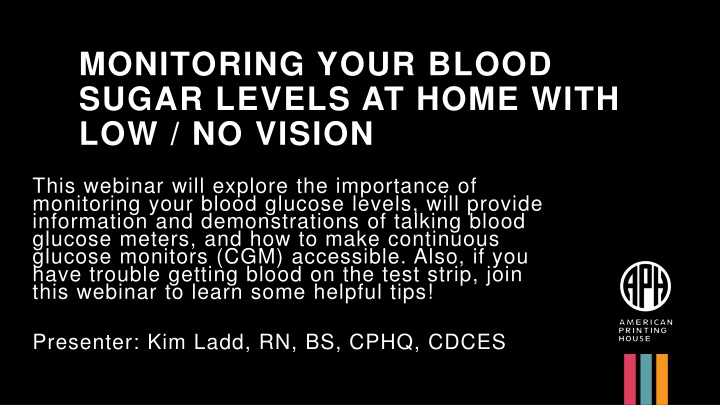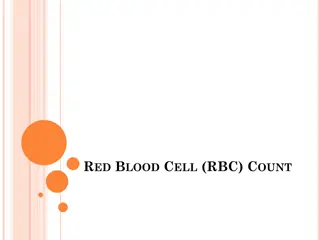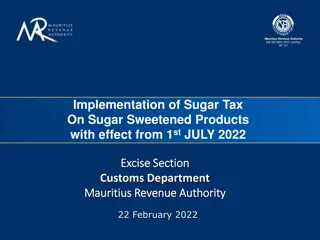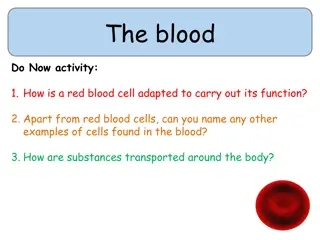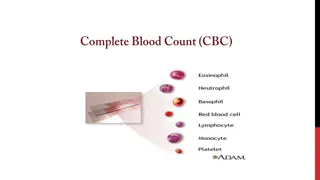Managing Blood Sugar Levels at Home for Low/No Vision
Explore the importance of monitoring blood glucose levels at home for individuals with low/no vision, learn about talking blood glucose meters, and make continuous glucose monitors accessible. Understand why maintaining blood sugar levels is crucial to prevent complications in diabetes, and get tips on testing and managing blood sugar levels effectively.
Download Presentation

Please find below an Image/Link to download the presentation.
The content on the website is provided AS IS for your information and personal use only. It may not be sold, licensed, or shared on other websites without obtaining consent from the author.If you encounter any issues during the download, it is possible that the publisher has removed the file from their server.
You are allowed to download the files provided on this website for personal or commercial use, subject to the condition that they are used lawfully. All files are the property of their respective owners.
The content on the website is provided AS IS for your information and personal use only. It may not be sold, licensed, or shared on other websites without obtaining consent from the author.
E N D
Presentation Transcript
MONITORING YOUR BLOOD SUGAR LEVELS AT HOME WITH LOW / NO VISION This webinar will explore the importance of monitoring your blood glucose levels, will provide information and demonstrations of talking blood glucose meters, and how to make continuous glucose monitors (CGM) accessible. Also, if you have trouble getting blood on the test strip, join this webinar to learn some helpful tips! Presenter: Kim Ladd, RN, BS, CPHQ, CDCES
Diabetes Mellitus Definition A chronic disorder of carbohydrate metabolism resulting from inadequate production or utilization of insulin. With diabetes, your pancreas either doesn't make enough insulin or your body can't use its own insulin effectively.
Why is Maintaining Blood Sugar Levels So Important? To Prevent Complications The cornerstone of diabetes management is to maintain blood sugar levels to prevent complications. It is the complications of diabetes that cause morbidity and mortality.
How Does Diabetes Cause Complications? Sugar is an irritant in the bloodstream. When it stays in the bloodstream because you do not have enough insulin to move it into your cells, it causes damage to blood vessels and nerves which leads to organ, muscle, and cell damage. Controlling Your Diabetes = Preventing Complications
Diabetes Complications sexual problems kidney failure gastroparesis neuropathy neuropathic pain foot ulcers lower-extremity amputations cardiovascular disease diabetic eye disease slow-healing wounds infections of the kidneys, skin, bladder bladder dysfunction gum disease & gum infections
Blood Sugar Levels and Goals Testing blood sugar levels at home with a glucometer provides a snapshot of diabetes management and provides data for understanding what and how food, activity, medicine, and lifestyle affect blood sugar levels. 80- 130 mg/dl fasting and between meals <180 mg/dl 2 hrs after meals >180 mg/dl is too high (hyperglycemia) <70 mg/dl is too low (hypoglycemia)
High and Low Blood Sugar Levels Low Blood Sugar (less than 70 mg/dcl) and High Blood Sugar (higher than 180 mg/dcl) Levels
Tips: Keep testing supplies together, organized and easy-to- find Each meter takes specific strips (strips are not interchangeable) Out-of-date strips aren t guaranteed to return true results Set up everything before getting blood on strip
Tips for getting enough blood for testing Make sure you are hydrated Wash your hands with warm water Hang arm to your side for a few minutes before testing to help blood flow Apply a warm compress prior to testing Massage hand prior to testing Apply pressure to finger before and during lancing it Don t test on the same finger each time Adjust the lancing depth
Talking Glucometer Demonstrations Prodigy Voice Prodigy Autocode ReliOn Premier Voice
Thumb-Guide Method 1. Gather all of your needed diabetes testing supplies 2. Wash your hands 3. Prepare your lancing device 4. Insert monitoring strip into your glucometer 5. Place your thumb on the finger pad of the chosen finger (both the finger and thumb are from the same hand) and apply slight pressure
Thumb-Guide Method 6. Place this hand on a hard surface to help stabilize and do not move your thumb until after the blood sample has been obtained 7. Using your free hand, pick up your lancing device and place it on your thumb nail and slide it down until it makes contact with the finger pad of the finger you are pricking 8. Prick finger and remove lancing device, but do not move your thumb
Thumb-Guide Method 9. Using your free hand, pick up your glucometer and hold it like a pen with the end of the strip facing down. Place the end of the strip on your thumb nail and slide it down until it makes contact with the pad of the finger you just pricked and hold it in place for about 3 seconds 10. If a blood sample is not obtained move the end of the strip to another spot, make contact with the finger pad, and hold it in place for about 3 seconds (be sure to not slide the strip on your finger, rather, pick it up and move it to another position on your finger pad)
Thumb-Guide Method 11. Continue steps 9 and 10 until the blood sample is obtained This technique helps to milk your finger tip by applying slight pressure to the finger pad giving you a greater chance of having a blood sample large enough to test. It also provides a landmark and smaller surface area to explore with your test strip which increases your chances of locating the blood sample.
How To Get a Talking Glucometer Get a doctor s order for insurance to pay for it If denied by insurance, have doctor override decision with a medical necessity appeal Pay out of pocket (does not require a doctor s order) Buy glucometer at retail pharmacies, online, mail-order companies, Accessible Pharmacy
CGMs (Continuous Glucose Monitors) A continuous glucose monitor (CGM) is a device used for monitoring blood glucose levels through interstitial fluid on a continual basis. A CGM takes a blood sugar reading on set intervals via a sensor that has a thin, flexible filament inserted just under the skin and held in place by an adhesive; it sends the data to either a reader device, an app, or both. CGMs can be a good choice for people with diabetes and vision loss, as they do not require finger sticks. The readers are not accessible, but the CGMs listed have an app that can be used with Talk Back on an android phone or Voice Over on an iPhone to make them accessible. **All phones are not able to download the apps, check your phone s ability before getting a CGM.
Freestyle Libre and Freestyle Libre 2 CGM The FreeStyle Libre is a continuous glucose monitoring system consisting of a handheld reader and a sensor worn on the back of the upper arm. The sensor measures glucose every minute. Use the handheld reader or the phone app to scan the sensor to find out your blood sugar level; you can scan the sensor as often as you like, even through clothing.
Freestyle Libre and Freestyle Libre 2 CGM FDA-cleared for adults and children 4 years and older The Freestyle Libre 2 has optional, real-time glucose alarms that notify you if you go too low or too high, however, at this time the accessible app for the Libre 2 is still under FDA review Each scan of the sensor provides a current glucose reading, a trend arrow, an 8-hour history and is water- resistant The sensor must be changed every 14 days and takes 1 hour after insertion to calibrate before it can be used
Freestyle Libre and Freestyle Libre 2 CGM User experience
Dexcom G6 CGM Dexcom CGM was the world s first CGM system. It tracks your glucose levels continuously throughout the day and night and sends your glucose reading to your smart device or receiver every 5 minutes.
Dexcom G6 CGM FDA cleared for ages 2 years and older Sensor is usually applied to the abdominal area The Dexcom G6 features a 10-day wear sensor that is water-resistant and easy-to-insert with an auto-applicator; it takes 2 hours to calibrate before it will send readings. The transmitter needs to be changed every 30 days Has a Share and Follow app that can link your readings to a family member to share your real-time results
Dexcom G6 CGM User experience
CGMs Discussion on getting a CGM for your use Guidelines Costs DME company vs pharmacy
Resources/ Handouts: How to Get a Talking Meter to Test Blood Glucose Levels at Home The Thumb Guide Method Continuous Glucose Monitors
